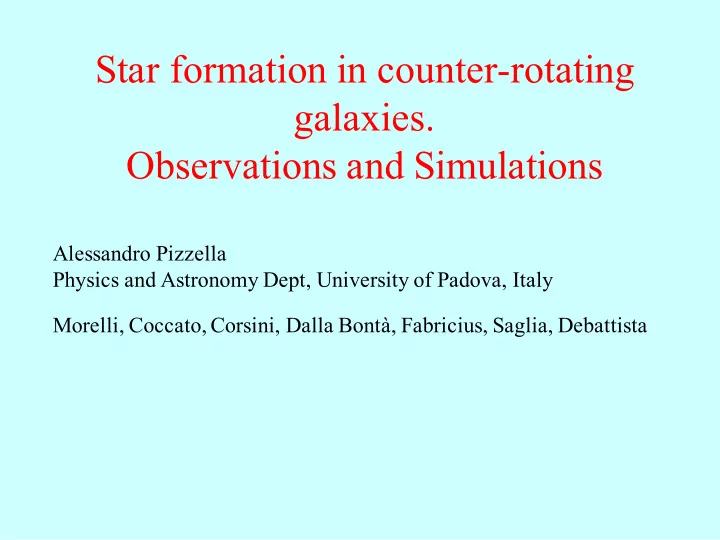

Star formation in counter-rotating galaxies. Observations and Simulations Alessandro Pizzella Physics and Astronomy Dept, University of Padova, Italy Morelli, Coccato, Corsini, Dalla Bontà, Fabricius, Saglia, Debattista
Summary - MUSE spectroscopic Observations – results - Modelling the counter-rotation with simulations – results
- Counter-rotation: when in one galaxy components with opposite spin co-exits (see review by Corsini 2014) - Stars vs. Gas - Stars vs. Stars - Stars vs. (Stars + Gas) - whole galaxy - inner/outer region - About 15% of S0 counter-rotates Pizzella et al.(2004) - We can detect up to a fraction of 20% (in luminosity) counter-rotating stars
MUSE @VLT à IC 719 – S0 27kpc; B =14.00 T Reconstructed image spaxel 0.2”x0.2”, seeing~1.4”
IC 719 Ca Triplet region MUSE@VLT Δλ =2.5Å R=2000-3500 ; σ = 65 - 35 km/s
IC 719: full spectral fitting Stellar templates eMiles-MIUSCAT (Vazdekis et al. 2012) pPXF (Cappellari & Emsellem 2004) based code (Coccato et al. 2011)
MUSE@VLT - IC 719: full spectral fitting
For each of the two stellar components we can measure: - kinematics: velocity and velocity dispersion - line strength à age and metallicity - the luminosity ratio Main/secondary à spatial shape
IC 719 kinematics -Velocity field Secondary Main component component Main=70% of total light 1'x1' Ionized gas
IC 719 kinematics -Velocity dispersion Secondary Main component component 1'x1' Ionized gas
Major Axis Velocity Velocity dispersion
IC 719 2d maps: Lick Indices Mg b Hβ
Main Secondary
MUSE - IC 719 Narrow band imaging Hβ Hα [SII]671 nm [NII]658 nm
Observational Results - Secondary component: same kinematics and same spatial distribution as the ionized gas. - Secondary component: younger and metal poor in comparison with the main component (see also Katkov, Sil’chenko et al 2013) - There is Star formation associated to the secondary component - Secondary component: thinner (q<0.15) than the main component (q=0.2-0.3)
Observations - Conclusions - The counter-rotating stellar component originated from a gaseous disk. - The cold gas, acquired from outside, settled onto the galaxy plane and formed the counter-rotating stars than now form a young, star forming thin disk
IC 719 one of the ETG in the sample with the brightest and more extended HI emission ( Grossi et al. 2009 )
We now need models to compare with Goals: test observational limits – understand the processes THE MODEL : Number of stars particles=1,838,606; Total Mass=5.683e10 Msun; Spatial resolution=50pc. Stars of different ages: stars older than 6 Gyr represent 2/3 of the total mass of the galaxy and we assume are the prograde stellar component (Debattista in prep.) . We used the code SYNTRA (Portaluri+2017 MNRAS 467, 1008) à simulated MUSE datacube
RESULTS : the machine is working. We successfully recovered the original velocity field of both the pro-grade and counter- rotating components. NEXT STEPS: Measurements : the minimum percentage of counter-rotating stars we can detect recovering the kinematics, age and metallicity of the stellar populations; Science : the astrophysical process that brings to the formation of such galaxies.
Summary - The counter-rotating disk is cold, thin, metal poor and young. - The counter-rotating stellar component originated from the gaseous disk that formed form the acquisition of a gas cloud - We started modelling the formation of such galaxies to properly test observational limits and better understand the acquisition mechanism.
- Counter-rotation: when in one galaxy components with opposite spin co-exits (see review by Corsini 2014) - Stars vs. Gas - Stars vs. Stars - Gas vs. Gas - Stars vs. (Stars + Gas) - whole galaxy - inner/outer region - About 15% of S0 counter-rotates Pizzella et al.(2004) - We can detect up to a fraction of 20% (in luminosity) counter-rotating stars
Distribution of ages n. of Prograde star particles 6-->8 Gyr=213,355 8-->11 Gyr=1,002,081 n. of Counter-rotating particles 0-->2 Gyr=213,858 2-->4 Gyr=257,693 4-->6 Gyr=151,619
IC 719 kinematics -Velocity field Main stellar component Secondary component 1'x1' Main=70% of total light 1'x1' Ionized gas
IC 719 ages and metallicities of stellar populations
Recommend
More recommend